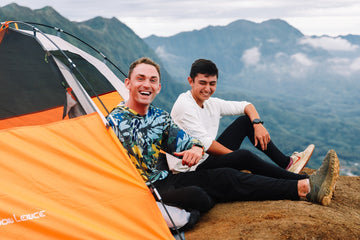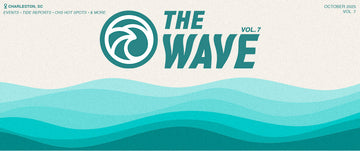Just when you thought ultimate freedom meant having wireless earbuds, along comes this thing called backpacking. Backpacking is a delightful mix of hiking and camping that lets you wander and roam to your heart’s content, plopping down for the night when it’s time to slumber.
Everything you need for your adventure is right there on your back, which means you have no ties to your home, car or storage shed. But it also means you’ll have to carry and wear just the right stuff or you’ll be longing for home in an instant. Here comes a slate of info beginners need to know for a first-time backpacking trip.
Backpacking Trip Do’s

To make sure your fun adventure is actually fun, you’ll want to adhere to this list of things to do.
- Plan ahead.
- Choose your destination.
- Go with a friend or experienced backpacker.
- Select essential gear and clothing.
- Plan your food.
- Pack it in, pack it out.
1. Plan Ahead
You may have heard the phrase: “A goal without a plan is just a wish.” Well, a backpacking trip without a plan is just a disaster. Yeah, logistics can be kind of boring. But a few minutes of boredom is worth the ease and comfort you’ll enjoy knowing you planned ahead. Points to cover:
- Transportation: How will you get there? Car, bus, camel?
- Trail options: Sunny and open or shady and woodsy?
- The date: What will the weather conditions be like? What about the tourist count?
- Your navigational skills: Do you remember how to use a compass (that’s not on your phone)?
- Your outdoor skills: Would a backpacking course be helpful? Now, be honest!
2. Choose Your Destination
While a backpacking adventure down the Grand Canyon or Yosemite Valley may sound thrilling, they probably aren’t the best destinations for a first-time trip. You instead want to pick a destination that is:
- Close to home, so you can get there quickly and start the fun
- Well-traveled and established, so you don’t get lost, or at least too lost
- Near water, so you have something to drink (Gatorade only lasts so long)
- Stocked with shorter trails, so you're not stuck lugging your pack across massive distances
3. Go with a Friend or Experienced Backpacker
Remember the buddy system from elementary school? When it comes to your first backpacking trip, you want that going in full force. Having someone with you can be a lifesaver, literally. It also means you have someone who can carry half the gear.
4. Select Essential Gear and Clothing
Even with your buddy carrying half the gear, your load can get heavy, fast. That’s why you want to stick with just the essential backpacking gear and clothing. No, you can’t take a U-Haul into the woods.
Essential Backpacking Gear

- Tent
- Backpack
- Sleeping bag and pad
- Water treatment
- Stove
- Kitchen supplies
- Headlamp
- Other
Tent: A single two-person tent is lighter and easier to carry than two single-person tents. A tent rated for three seasons should suffice, as your first backpacking trip should not be in the dead of winter.
Backpack: You want a pack that is both roomy and comfortable, especially in the shoulder and hip areas. Keep in mind that lightweight backpacks have less padding.
Sleeping bag and sleeping pad: Unless you want to spend a zillion dollars and only use your sleeping bag in the winter, opt for a synthetic sleeping bag over a down sleeping bag. Bring a sleeping pad for cushy comfort. Consider a stuff sack to keep your sleeping bag compact.
Water treatment: No matter how pristine the wilderness water source may look, you’ll never know what’s in it unless you bring a microscope. And they are much too heavy to carry. So, bring some type of water treatment instead. Go for chemical drops or tablets you can add to the water in your water bottle.
Stove: You’re going to want some type of contraption that can heat up your food. A small, lightweight camping stove can work, or you can opt for a small stove specifically designed for backpacking. Don’t forget to bring an extra bottle or canister of fuel.
Kitchen supplies: Go for the minimum amount of kitchen-ey things. One plate. One pot or pan. One cup. Water bottle. A knife. A spork. You get the idea. Don’t forget the biodegradable dish soap and a small sponge and towel.
Headlamp: Easier to use than a flashlight, headlamps are a backpacker’s best friend. Well, second-best friend after the cushy sleep pad. Opt for a lightweight headlamp and bring along an extra set of batteries.
Other: Anything else you simply can’t live without? Maybe duct tape for impromptu repairs. Maybe toilet paper for, well, you know.
Essential Backpacking Clothing

Get shopping! Although adventuresome folks may already have the bulk of the clothes they’ll need, there’s no harm in buying something special to celebrate a brand-new adventure. In truth, you don’t need tons of clothes, just the right clothes, especially for sun protection.
Must-have backpacking clothing consists of:
- Base layer
- Insulation layer
- Outer layer
- Rainwear
- Hiking shoes
- Hat
Base layer: Performance leggings are good choices for the bottom, coupled with a performance shirt for the top.
Insulation layer: The amount of insulation you need depends on the weather. A thermal hoodie works well if you expect cold temperatures. T-shirts and camper shorts work for warmer weather.
Outer layer: Performance hoodies make exceptional outer layers, giving you both comfort and sun protection.
Rainwear: A waterproof parka or other type of rain protection is a must. If you’re caught in the pouring rain, you don’t care how stupid you might look in one of those shapeless, clear ponchos.
Hiking shoes: Remember when you wore your new running shoes on an extended jog and came back with blisters? Don’t do that. Make sure whatever hiking boots or shoes you choose are comfy, broken-in, and provide adequate traction. Pair them with wool or synthetic socks.
Hat: Offset the uncool look of the rain poncho with a super-cool hat. Like an all-purpose trucker hat.
5. Plan Your Food
Hiking can make you hungry. The fresh air can make you hungry. The idea of not being able to order a pizza can make you hungry. In other words, make sure you bring enough food.
If you’re doing a one-night trip, plan for breakfast, dinner, two lunches, and snacks. Plenty of snacks.
Do bring:
- Non-perishable foods, like peanut butter and jerky
- High-calorie, high-protein trail mix and energy bars
- Instant coffee or tea mixes
- Pre-cooked, readymade meals, like packaged rice or noodle entrees
- Heavy canned foods
- Eggs, milk, raw meat or anything that needs refrigeration
- Anything elaborate that needs extensive preparation
6. Pack It In, Pack It Out

If you’re the outdoor type, you probably have the Leave No Trace guidelines memorized. But there’s no harm in reviewing them again. This set of seven principals was created by the Leave No Trace organization, which likes when you repeat the principals verbatim.
The Seven Leave No Trace Principles:
- Plan ahead and prepare.
- Travel and camp on durable surfaces.
- Dispose of waste properly.
- Leave what you find.
- Minimize campfire impacts.
- Respect wildlife.
- Be considerate of others.
Backpacking Trip Don’ts
Knowing what to do for your first trip is good. Knowing what mistakes to avoid can be even better. No matter where or when you go backpacking, here’s what you don’t want to do:
- Don’t pack too much gear.
- Don’t test gear for the first time.
- Don’t try to tackle too much.
- Don’t forget to consider elevation gain.
1. Don't Pack Too Much Gear
Everything you bring is going to be attached to your back. The lighter your backpack, the happier you’ll be. Believe us.
A good rule of thumb is to ensure your loaded pack doesn’t weigh more than about 20 percent of your own bodyweight. Ultralight backpacking is dreamy. Backpack overload is a nightmare.
2. Don’t Test Gear for the First Time
You wouldn’t jump out of a plane without knowing how to use the parachute, would you? The same holds true for backpacking gear. Make sure you set up the tent, turn on the stove and spot-check your headlamp before you go.
3. Don’t Try to Tackle Too Much
Your first backpacking trip is going to be one you remember for the rest of your life. Just make sure you don’t remember it as a grueling, miserable, multi-day hike that left you depleted and lost in some random wilderness area of a national park.
Keep your trip short, sweet and easy. You can always plan longer hikes and more complex adventures as you become more experienced.
4. Don’t Forget to Consider Elevation Gain
While all the time outdoors is surely enough to make you naturally high on life, you don’t want to go too high up the mountain. The more elevation you add to your adventures, the tougher those adventures are going to be.
As a new backpacker, you’ll want to stick with trails that have an elevation gain of less than 500 feet. Even experienced backpackers often stick with lower elevation gain. FYI, here’s a quick rundown on the difficulty rating of different elevations:
- Easy: 500 feet or less
- Moderate: More than 1,500 feet
- Hard: More than 3,000 feet
- Very hard: More than 4,500 feet
- Panting, gasping and wishing you were anywhere else but there: More than 6,000 feet
Not sure how high up the trails go in the area you want to visit? Find a topographic map online. Those things are cool.
Enjoy the Journey!

Now that you know the backpacking do’s, explored the don’ts, and have properly memorized the Leave No Trace principals, you’re in excellent shape. The only thing left on your agenda is to make sure you’re headlamp has working batteries. Oh yeah and get your hands on a super-cool trucker hat. Happy trails!





